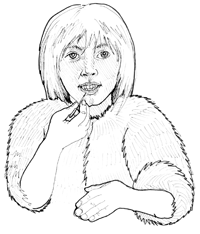STRANGE BUT TRUE- Don't be picky: 'Splendid splinters' can be deadly

DRAWING BY DEBORAH DERR McCLINTOCK
Q. They're the oldest nonlithic tools in service of the oldest human habit. The American writer Sherwood Anderson died from using one of these– and you could, too. –D.J.Bickers
A. It's toothpicks and toothpicking, answers Henry Petroski in American Scientist magazine. The two-million-year-old variety, say anthropologists, may have been grass stalks with hard silica particles that made distinctive grooves in hominin fossil teeth. With civilization came other materials. Wooden toothpicks date to about the 16th century, when a community of Portuguese nuns sold a sticky confection and provided picks to handle the sweets and clean the teeth afterward. Today, some tens of billions of the implements are produced worldwide, prompting a still-ongoing debate over their proper place in society, public vs. private, etc.
These erstwhile "splendid splinters" are far from splendid for the estimated 8,000 toothpick users injured annually in the U.S. alone, most from inadvertent swallowing, as probably happened to Sherwood Anderson. Some safety features have recently been incorporated, such as the emergency catch loop or the Japanese variety with a pointed end and a blunt one, often decorated.
Q. What's one of the strangest, most inexplicable times anyone might choose to disrobe? –L. Godiva
A. "Paradoxical undressing" is well known to mountain rescuers who in freezing weather will encounter sufferers of hypothermia who refuse warming blankets and may even have removed some of their clothing, says New Scientist magazine. In fact, 20-50 percent of deaths from hypothermia involve paradoxical undressing of some kind. One theory is that the fine blood vessels near the skin's surface contract to slow heat loss, then as contracting muscles become exhausted, blood rushes to the skin and causes a deep flush and sense of overheating. Caught in the confusion of the moment, the victim disrobes to try to cool off. Or maybe the brain's overstressed hypothalamus goes awry.
Equally mysterious is "terminal burrowing," or "hide- and-die syndrome," seen also in certain cats and other species. When things get really bad, they find somewhere to "curl up and die," which explains why some people are found dead behind wardrobes or under beds. One elderly man whose furnace had failed was discovered partly undressed and under overturned furniture, with bruises all over his hands. Police suspected foul play, but an autopsy revealed hypothermia as the cause of death.
Q. At a party among strangers, do you think you could match up spouses based on facial appearance alone? –B. Pitt
A. You'd probably do best on couples married 25 years or more, says psychologist Robert Zajonc. When he had volunteers try to pair up photos of young married couples, they were unable to do so any better than chance; but they fared better pairing up photos of long-time marrieds.
This is the old idea of couples growing to look alike. Empathic facial expressions during shared joys and sorrows may have etched similar skinlines, since it is well-known that people tend to mimic the expressions of those around them, especially those to whom they feel close.
Interestingly, the couples most often matched up correctly had reported the most satisfying marriages.
Q. Outfit a football helmet with a Head Impact Telemetry (HIT) System and now what tales of hard knocks might it tell? Listen up, coaches and docs. –J. Jayne
A. The system– incorporating six accelerometers, a temperature sensor, plus a wireless signalling transceiver– is a little like having a doctor on the field who transmits data to the sidelines about the extent of blows to a player's head, the part of the helmet hit, etc, says Willie D. Jones in IEEE Spectrum magazine.
Since the HIT package sits inside the helmet right up against the head, the impact to the skull itself is measured (sides can be worse than the front or top). In one study, college players were found to endure 50 impacts per game of about 40 g's per blow, similar to that of a boxer. In other analyses, "lights-out" hits of pros often exceeded 100 g's, jarring as a car crash.
The signs of brain injury– headache, nausea, short-term memory loss– are tough for coaches and trainers to spot. So the HIT system is a real-time early-warning system to help determine if a player needs to sit out the rest of the game or get medical attention, perhaps for one of the estimated 230,000 football concussions annually in the U.S.
Send Strange questions to brothers Bill and Rich at [email protected].
#